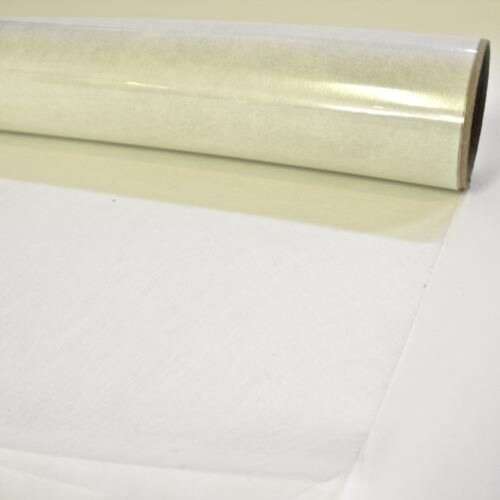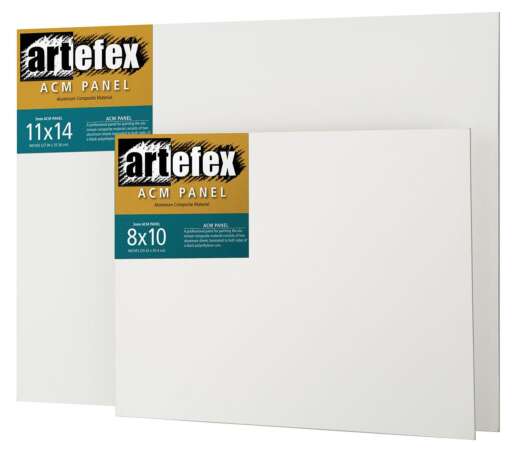BEVA 371 Film
BEVA 371 solution in film form. The film comes sandwiched between a white silicone-coated paper and a Mylar release sheet. This item does not qualify for free shipping.
This is pure BEVA® 371 Solution in film form. The film comes sandwiched between a white silicone-coated paper and a Mylar release sheet. The transparent support allows the film to be cut precisely to any shape, inserted into loose areas, or for delaminating paint to be correctly aligned—all before the film is heat-activated—ideal for the transparent lining of paintings and textile and paper conservation.
For easy application, BEVA 371 solution has been sprayed into film form for easy workability without flammable solvents and in applications where liquid BEVA may not be suitable. Transparent, ideal for relining dark canvas with Mylar or Stabiltex. Very smooth, will not trap air bubbles, not tacky at room temperature, non-toxic, non-flammable. Most often activated by heat, thus eliminating the need for ventilation of evaporated solvents. One mil (.0010")(12.5 microns) thickness is suitable for mounting lightweight papers and fabrics. 2.5 mils (.0025") (67 microns) thickness is for use on canvas and heavyweight materials. The 2.5 mils is also available in 54" wide rolls, eliminating the need for multiple adhesive strips on larger surfaces. This product has the same properties, including reversibility, as BEVA 371 solution.
Please note that this material liquefies at 65°C (150°F).
BEVA® 371 Formulations
BEVA 371, originally formulated by Gustav A. Berger, is unique among adhesives used for consolidation treatments, as it is a multi-component mixture and was designed specifically for the conservation field using the best technology available at the time. BEVA Original formula contained solvents, Elvax 150, AC400, Laropal K80, Cellolyn, and wax.
When Gustav Berger developed BEVA 371, he realized that some of the components might become unavailable in the future.* In the 1990s, Conservator's Products Company collaborated with Mr. Berger to identify new components which could be used to replace any of the five existing compounds in BEVA 371. When Laropal K80 (formerly Ketone N) was discontinued by BASF in 2008, they chose an aldehyde ketone resin to replace the Laropal K80, a ketone resin. This resin, like the Laropal K80, gives strength and elasticity to the adhesive.
The reformulated adhesive is designated BEVA 371b. It is slightly more yellow than the BEVA 371 (original formula) because the new resin is more yellow. However, it is equivalent to BEVA 371 in all other properties, such as:
- Good solubility in hydrocarbon solvents (VMP naphtha, toluene, etc.)
- Same activation temperature of 150º F or 65º C
- Good adhesion to various substrates (canvas, metal, wood, plastic, etc.)
- High peel strength
- Good reversibility with solvents or heat
- Equivalent stability in both thermal and chemical
* Cited from Berger, Gustav A., Russell, William H., Conservation of Paintings: Research and Innovations. United Kingdom: Archetype Publications, 2000. Chapter 8. ISBN 1873132379
Source: Conservators Products
BEVA 371a (2021–now) contains solvents, Elvax 150, AC400, Laropal A81, Cellolyn, and wax. TegoVariplus went out of production and was replaced by Laropal A81, a white/clear resin.
BEVA 371b (2009–2021) contains solvents, Elvax 150, AC400, TegoVariplus, Cellolyn, and wax. Laropal K80 went out of production and was replaced by TegoVariplus, a yellowish resin.
Today, BEVA 371 film uses BEVA 371b formulation.
There are efforts underway now by a group of conservators and polymer scientists to reformulate BEVA in order to get it closer to the original formula.
Specifications
| Item | Thickness | Width | Length |
| BEVA 371 Film | 2.5 mil | 27 inches | 20 feet |
Reversibility
BEVA® 371 Film can be removed from absorbent surfaces using hexane or acetone, provided these solvents do not damage the artwork. It is also reversible by heat and low-aromatic petroleum solvents.
Instructions for Using BEVA® 371 Film
The BEVA® 371 Film is a heat-activated adhesive, initially developed by Gustav Berger for relining old deteriorating or torn canvases with a new structurally sound canvas. Since its development, BEVA® 371 Film has proven to be a very effective adhesive in many other areas of application, such as with paper, canvas, textiles, films, wood, metal, plaster, and boards, to name a few.
When you receive the BEVA® 371 Film, you will notice that it is composed of two materials rolled together, one of which contains the BEVA® 371 Film, the other of which is a release layer. The white paper is a silicone-coated paper; this is the release layer. The other transparent sheet is a polyester (Mylar) film, one side of which has been coated with the BEVA® 371 adhesive. The side of the transparent sheet facing the release paper is the side coated with BEVA® 371. If you accidentally separate the layers and lose track of which side is which, the side coated with BEVA® 371 will feel slightly tacky (using a fingernail, you can scrape a bit of the adhesive at the edge to confirm you have identified the correct side.)
The process of working with the film is as follows:
1. With the intact two layers (clear Mylar and white paper), cut the film to size for your application.
2. Separate the transparent layer, and lay the sticky side towards the release paper (this is the side coated with BEVA® 371) down onto the back of one of the materials to be mounted.
3. Keep the transparent film and the material to which it is being applied stationary—using an iron set at 150° F, iron the transparent plastic sheet down to the material, working slowly and carefully to cover the entire surface.
4. Once it has cooled, peel away the plastic, leaving behind a layer of adhesive on the surface, which has been transferred down to your material.
5. Take the other material you wish to mount to this one and place it on the adhesive you have just prepared. Again with your iron set at 150 ° F, heat is applied, which will melt the adhesive between the two materials, adhering them together. Should it be of concern to iron on top of this layer (be it a painting, drawing, etc.), the silicone-coated white paper can be used as a barrier, as nothing will stick to the smooth side of this material.
Note: The final application of heat may take longer than in the first step, as the heat must now pass through multiple layers of material to come up to temperature and activate the adhesive.
Things to Consider
Although it is not necessary to coat both sides of the material with BEVA® 371, consider carefully which side it will be easier to apply to first.
BEVA® 371 is an excellent product for mounting significant oversized works precisely because you first apply it to one surface. When it cools, and the release liner is removed, the adhesive is not tacky, which allows for slow, careful placement onto the second material to which it is to be mounted before it is ironed down into place.
Should difficulty be encountered while mounting the piece, it can be reheated with an iron to melt the adhesive, separating the layers, and the process starts over.
Make sure you are working with the film at the correct temperature. Ordinary dry mounting adhesives operate at 250° F, so the 150° F for the BEVA® 371 is relatively low and perfectly safe for most materials. Using an iron at too low a temperature will result in insufficient adhesion of the product while having the temperature too high will result in possible damage to all materials in contact.
Should the only iron you have at your disposal by a household iron without temperature controls, you can do the following: With a small piece of film and a piece of paper, start with the iron on the lowest possible setting, and try to adhere the film to the paper. Keep increasing the iron temperature until the BEVA® 371 Film starts to adhere to the paper; increase the temperature slightly and mark the dial so you can return to this setting in the future.
Check all materials that you are working with, such as plastics, rubbers, encaustic paintings, etc., can handle the heat required for use with this product before use with their respective manufacturers.
Test the product carefully for suitability with your materials and that you are comfortable using it before working on the original artwork.
Disclaimer
The information contained herein is for educational purposes. However, the information is provided without any representation or warranty, expressed or implied, regarding its performance.
The materials, environment, and other factors with which this product may be used are beyond our control and may be beyond our knowledge. For this and other reasons, we do not assume responsibility and expressly disclaim liability for loss, damage, or expense arising out of or in any way connected with the use of this product.
| SKU | 510-3702 |
|---|---|
| Brand | Conservators Products |
| Vendor | Conservators Products |
| Processing Time | Usually ships the next business day. |




